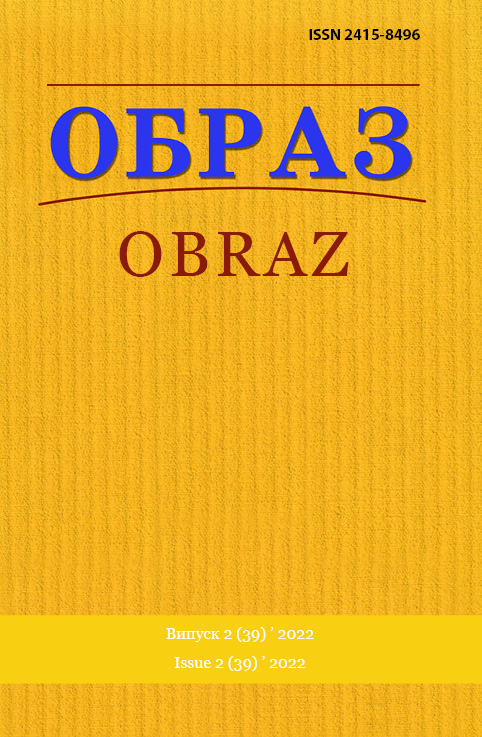Abstract
Introduction. In 2019, a new version of spelling was approved in Ukraine. However, Ukrainian mass media experiences some problems with the new norms. Meanwhile, the correct usage of language in mass media is extremely important, because journalistic texts have a large audience and can be used by readers as a certain model. Thus, it’s important to discover specifics of new norms usage in online mass media to understand the level of the norms compliance.
Relevance and purpose. The purpose of the article is to propose an algorithm for computer analysis of texts, which allows to investigate compliance with new spelling norms by leading Ukrainian online media, as well as to determine whether the situation in the media changes over time. This study is relevant, because a comprehensive study of the new language norms usage in online massmedia is lacking, scientists focused their attention on individual norms and the number of texts in sample wasn’t large.
Methodology. Computer analysis: with Python programs more than 8 thousand news items were collected from the leading online media. Vocabularies with old and new language norms were designed. Comparative analysis: usage of foreign components, variable spelling changes, spelling of the international sites and Internet resources, spelling of certain words were compared in the mass media in 2019 and 2021.
Results. It was determined that the authors of the publications did not adapt to the variable spelling changes. Regarding mandatory changes, problems were observed with the spelling of the names of international websites and Internet resources, as well as some words. The situation with the use of feminine forms was the most stable. Spelling of words with the first foreign component, as well as with part «half/piv-» was observed in two versions: old and new spelling.
Conclusions. The situation with the new spelling in Ukrainian online media is improving over time, although the acceptance of the new norms is still very slow. Moreover, this situation is observed precisely in the segment of quality Ukrainian media, which adhere to professional standards and are an example for many journalists to follow. With this in mind, we recommend that the editors of the online mass-media take measures to improve the situation.
References
1. White List: 10 the Most Qualitative Media, available at: https://imi.org.ua/monitorings/ bilyj-spysok-10-media-shho-staly-najyakisnishymy-i41541 (accessed 22 April 202).
2. Bodra, І.А., & Kochukova, N.І. (2019), «Functioning of femininities in the language of Ukrainian online publications», Naukovyj Visnyk Drogobyczkogo Derzhavnogo Pedagogichnogo Universytetu Imeni Ivana Franka. Seriya: Filologichni Nauky (Movoznavstvo) [Scientific Bulletin of Drohobych State Pedagogical University named after Ivan Franko. Series: Philological Sciences (Linguistics)], no. 12, pp. 90–93, available at: http://ddpu-filolvisnyk.com.ua/uploads/ arkhiv-nomerov/2019/NV_2019_12/NV_2019_12.pdf#page=90 (accessed 22 April 2022).
3. Bondarenko, O., & Ivanchenko, A. (2020), «Spelling of the highest government positions in the new spelling», Journalism Education in Ukraine: World Professional Standards: Proceedings of the 16th All-Ukrainian Scientific-practical Conference, Sumy State University, Sumy, pp. 21–23, available at: https://essuir.sumdu.edu.ua/bitstream-download/123456789/78516/3/ Journalism_Education.pdf#page=23 (accessed 18 April 2022).
4. Eismont, Yu. V. (2020), «New spelling: debatable issues», Visnyk Knyzhkovoyi Palaty [Bulletin of the Book Chamber], no. 9. pp. 15–19, available at: file:///C:/Users/Professional/ Downloads/vkp_2020_9_5.pdf (accessed 5 April 2022).
5. Yermolenko, S.Ya. (2018), «On the new edition of the Ukrainian spelling (transcript of the scientific report at the joint meeting of the Presidium of the NAS of Ukraine and the Board of the Ministry of Education and Science of Ukraine on October 24, 2018)», Visnyk Nacionalnoyi Akademiyi Nauk Ukrayiny [Bulletin of the National Academy of Sciences of Ukraine], no. 12, pp. 40–44, available at: http://dspace.nbuv.gov.ua/bitstream/handle/123456789/145785/08- Ermolenko.pdf?sequence=1 (accessed 15 April 2022).
6. Institute of Mass Media (2021), «Report on monitoring the observance of professional journalistic standards in online media. the fourth wave of monitoring in 2021. Professional Standards Research», available at: https://imi.org.ua/monitorings/zvit-z-monitoryngudotrymannya-profstandartiv-v-onlajn-media-chetverta-hvylya-monitoryngu-u-2021-i43157 (accessed 12 April 2022).
7. Cabinet of Ministers of Ukraine (2019), «Decree. From May 22, 2019, no. 437. Kyiv. The issue of Ukrainian spelling», available at: https://mova.gov.ua/diyalnist-i-proyekti/pravopis (accessed 12 April 2022).
8. Marchuk, L.M. (2019), «Linguocultural aspect of evaluative characteristics of femininities in the language of mass media», Naukovyj Visnyk Mizhnarodnogo Gumanitarnogo Universytetu. Seriya: Filologiya [Scientific Bulletin of the International Humanities University. Series: Philology], vol. 3, no. 38, pp. 118–121, available at: http://www.vestnik-philology.mgu.od.ua/ archive/v38/part_3/Filologi38_3.pdf#page=118 (accessed 11 April 2022).
9. Mukhina, A. (2022), «The state of implementation of changes in Ukrainian spelling on the example of the online publication «Ukrainska pravda»» Lingvokompyuterni Doslidzhennya [Linguocomputer Research]: Coll. Science, Vasyl’ Stus DonNU, Vinnytsia, iss. 15, pp. 210–212, available at: https://r.donnu.edu.ua/xmlui/bitstream/handle/123456789/2250/Лінгвокомпютерні%20дослідження%20.pdf?sequence=1&isAllowed=y#page=92 (accessed 27 April 2022).
10. Issues of Ukrainian spelling (2019), «Resolution of the Cabinet of Ministers of Ukraine of May 22, 2019, no. 437. Kyiv», available at: https://web.archive.org/web/20190606085457/ https://zakon.rada.gov.ua/laws/show/437-2019-%25D0%25BF (accessed 16 April 2022).
11. Stetsyk, H.M., & Tsygankova, V.O. (2019), «Project of new Ukrainian spelling», Flight. Modern problems of science: Proceedings of the 19th scientific-practical conference of higher education and young scientists, National Aviation University, Kyiv, iss. 2, pp. 289–290, available at: https://dspace.nau.edu.ua/bitstream/NAU/39590/1/Polit2019_Gumanitarni_nauki_T2- 290-291.pdf (accessed 23 April 2022).
12. «Ukrainian spelling», available at: https://mon.gov.ua/storage/app/media/zagalna%20 serednya/%202019.pdf (accessed 23 April 2022).
13. Yaroshenko, M. (2019). «Methodology and motivation of changes in the new edition of the Ukrainian language spelling», Ukrainian language yesterday, today, tomorrow in Ukraine and the world: Proceedings of the All-Ukrainian scientific-practical conference, MPU of Mykhailo’ Drahomanov NPU, Kyiv, pp. 162–166, available at: http://enpuir.npu.edu.ua/bitstream/ handle/123456789/26664/Ukrainska%20Mova%20Vchora%20Sohodni%20Zavtra%20V%20 Ukraini%20I%20Sviti_2019.pdf#page=162 (accessed 28 April 2022).

This work is licensed under a Creative Commons Attribution 4.0 International License.

